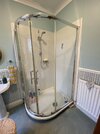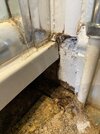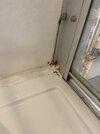Hi all, not long purchased our new home and getting on with sorting out leaks, damages and problems before Winter.
A problem I hadn’t immediately noticed was this leaking shower tray. Years ago I had a bath with a pivoting glass screen. To seal this I sealed the inside junction between the chrome hinge strip and the bath, and also added a uPVC strip at the bath edge.
With this ‘new shower’, I can’t figure out (without raking out the silicone) where the seal should be.
Can anybody share how they would stop this leak in the corner? I have good sanitary sealant (Dow) to replace it, but just wanted to know how I should re-seal it before starting.
A problem I hadn’t immediately noticed was this leaking shower tray. Years ago I had a bath with a pivoting glass screen. To seal this I sealed the inside junction between the chrome hinge strip and the bath, and also added a uPVC strip at the bath edge.
With this ‘new shower’, I can’t figure out (without raking out the silicone) where the seal should be.
Can anybody share how they would stop this leak in the corner? I have good sanitary sealant (Dow) to replace it, but just wanted to know how I should re-seal it before starting.






